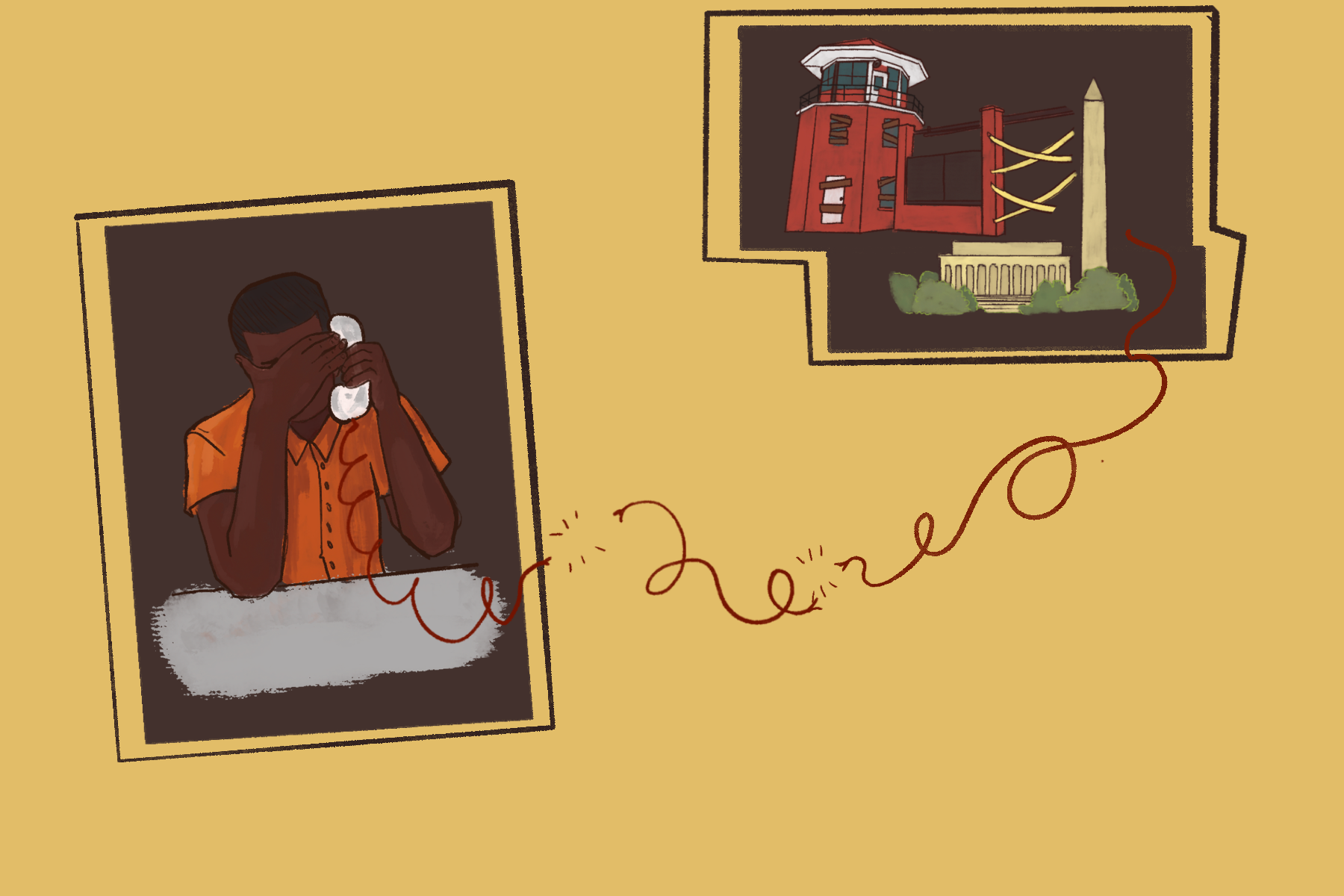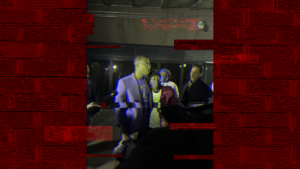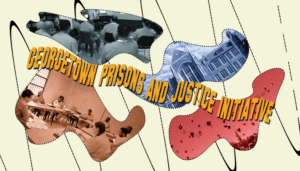Colie “Shaka” Long was born and raised in Washington, D.C., but in 1996, he was incarcerated and forced to leave “his city.” He didn’t return free until 26 years later.
Originally, Long was held in the Lorton Correctional Complex in Lorton, Virginia, about a 30-minute drive from the city. Four years later, Lorton closed, and the federal government transferred Long to Red Onion State Prison in Wise, Virginia, about a seven-hour drive from D.C.
Then, he was transferred to Indiana. Then California. Then Georgia. Then Pennsylvania. Then back to Virginia. Then, finally, to the D.C. Jail.
Washington, D.C. has not had its own prison since the 2001 closure of Lorton, under the Revitalization Act of 1997. Because D.C. doesn’t have a long-term detention facility, residents sentenced to over one year in prison have been arbitrarily moved across the country, based on the availability of beds.
Currently, the only correctional facilities in D.C. are the Central Detention Facility—widely referred to as the D.C. Jail—the Correctional Treatment Facility, and the Community Corrections Facilities, a halfway house for women. These are all classified as jails: short-term detention facilities that hold individuals pre-trial or for sentences shorter than one year.
Although Lorton was in Virginia, it was operated by the D.C. Department of Corrections and housed D.C. residents. Congress passed the Revitalization Act and shuttered Lorton in an effort to reduce D.C.’s expenditures after years of financial trouble.
The act dissolved the prison system in D.C. by closing Lorton and transferring custody of incarcerated people from D.C. to the Federal Bureau of Prisons (BoP). The law reassigned authority for parole decisions and community supervision responsibilities from D.C. to federal agencies.
Today, advocates are proposing different solutions to alleviate the challenges faced by incarcerated people from D.C. These span from the construction of a prison in the District to the abolition of the carceral system altogether, but all agree on one thing: D.C.’s incarcerated population is suffering.
Being moved out of the District creates barriers to rehabilitation for D.C. offenders, like a lack of family connection. The Revitalization Act mandates that people convicted under D.C. Code are incarcerated within 500 miles of D.C. when possible, but, according to the D.C. Policy Center, almost half of D.C. offenders are further away, making family visitation difficult.
“The role that family and loved ones play in maintaining humanity is pivotal,” Long said. “They remind the incarcerated person of their purpose because it’s so easy to lose the sense of purpose when you’re inside.”
Pam Bailey, a D.C. resident, said that visiting incarcerated people out of the District is difficult, time-consuming, and costly. Bailey co-founded the prison reform organization More Than Our Crimes with Rob Barton, a D.C. offender and former Georgetown Prison Scholars Program participant currently incarcerated in Florida. After the two met through a pen pal letter exchange, they created the organization to share the stories of incarcerated individuals, especially those with long sentences.
“I went down to visit Rob a couple weeks ago. It cost me $800. It’s airfare, rental car, and hotel. And a lot of these families are low income, and that is a lot of money,” Bailey said. “On top of that, I had to get all the way down there and they canceled the visit.”
The frequent transfer of D.C. offenders in the federal system makes it difficult not only to maintain connections with those outside of prison but also those made in the facility. When Lorton closed, those who were incarcerated together in D.C. were split up and forced apart.
“When they closed Lorton, they just submerged you in this hostile, foreign territory. It’s like we were war buddies,” Long said of his friends from D.C. who were also incarcerated in the federal system. “Your most direct and constant form of communication with other people is people that are inside.”
It is difficult for them to stay in touch with other D.C. natives unless, by chance, they end up in the same facility again, Long said.
Furthermore, this frequent transfer makes it so D.C. offenders are rarely in the same place long enough to reap the benefits of any educational programming while incarcerated. These include General Education Development and English as a Second Language classes, degree programs, and instruction in leisure activities.
“If there were educational programs, for example, in a federal prison like Indiana, you’re there for a couple months, even a couple years, then you move to a different facility,” Long said. “There’s no continuity.”
D.C. offenders are also disproportionately housed in high-security facilities, further decreasing their access to educational programming.
The BoP decides the type of facility people supervised by the federal system are incarcerated in and their educational programming access. According to an amicus brief filed by the D.C. Office of the Attorney General (OAG) in 2022, the BoP makes these decisions based on an individual’s “criminal history score,” but they use a separate, stricter score calculation system for D.C. offenders than for federal offenders. This means, the OAG alleged, that D.C. offenders are disproportionately housed in high-security facilities and have less eligibility for early-release programs. And, according to the brief, this system disproportionately impacts Black inmates.
Nearly 96% of D.C. offenders are Black, compared to around 40% of D.C. residents and 39% of federal offenders overall.
While incarcerated, D.C. natives face racism and discrimination not only from the system but also from federal offenders, Bailey said. D.C. offenders placed by the federal system are also mostly incarcerated for violent crimes, whereas federal offenders are more likely to be incarcerated for white-collar crimes.
“[D.C. offenders] are perceived as more violent,” Bailey said. “There’s a lot of racism involved. So really they’re discriminated against.”
With all the challenges that D.C. natives face when incarcerated outside the District, some advocates, including Bailey, believe that D.C. should build a new prison of its own.
“As far as I’m concerned, D.C. sold them up the river when they gave up all control of their criminal justice system to the feds,” Bailey said. “They owe it to them to bring them home.”
According to Bailey, building a prison in D.C. would allow for more continuous programming, which would give incarcerated people not only greater access to education but also a stronger connection to the community outside.
Long said a proposed D.C. prison would need to have a culture of healing that isn’t overly punitive and that offers community programming. He suggested something like the Georgetown Prison Scholars Program—which offers classes and lectures—that he enrolled in while at the D.C. Jail.
Long said that investing in programming within prisons could help those who are incarcerated have the support to succeed upon release.
“Especially in D.C., we are so response-based,” said Long. “Re-entry starts when you’re inside. So if we had a prison we would need close family connections, programming, therapy, counseling, all these kinds of things. That’s how you work towards building a safe community.”
A prison in D.C. would also make visitation much more accessible for District families with incarcerated loved ones, Bailey said.
“[Lorton] was a truly horrible place,” Bailey said. “But it doesn’t have to be that way. And at the very least they need to be close to home so they can have family visits.”
Long believes that having correctional staff from D.C. would also be beneficial to creating a community-oriented prison culture.
“Culture is everything. The Lorton correctional staff were from D.C.,” Long said. “A lot of the officers knew the incarcerated people.”
While some advocate for the construction of a D.C. prison, others advocate for the abolition of the prison system entirely, arguing that a new prison is antithetical to that goal.
“No new jails, no new prisons,” said Heath Pearson, an anthropology and Justice and Peace Studies professor at Georgetown who studies racial capitalism, prisons, and policing. “Supporting a building project is pretty much counter to my entire life project.”
Building a D.C. prison would not address the larger issue of mass incarceration, according to Pearson. D.C. already has one of the highest incarceration rates in the U.S., at 816 residents incarcerated per 100,000, compared to the national average of 614.
However, Bailey believes it is still a more viable immediate solution than long-term goals like abolition. Bailey doesn’t generally believe in building more prisons, but she said this is a unique case, as D.C. is the only area in the country without a “state-level” prison.
Focusing solely on abolition is unfair to incarcerated people who would benefit from short-term reforms, Bailey said.
“We are not getting rid of prisons anytime soon, if ever. It’s very cruel to take this attitude because there are more than 2,000 D.C. residents in the federal system, and it is unfair and punitive to them,” Bailey said.
Pearson is not convinced that a D.C. prison, or any prison, can be humane.
“Prisons are, as we speak, rapidly retooling to eliminate visitations altogether and turn them into only video chats and email messaging and mailing stuff,” Pearson said. “Who’s to say that one year after building the D.C. prison, they won’t say, ‘No more visitation. But I’m glad we got 800 extra beds out of it.’”
Pearson thinks advocates can help D.C. offenders by pressuring the government to follow the laws that they created. Rather than building a prison, he said the BoP should be held to the rule that D.C. offenders are kept within 500 miles of the city.
“One thing that you can do to create a sense of accountability around all of this is to say for every X number of miles you distance a person from their family, you are responsible for transporting their family X number of times a year,” Pearson said.
According to Pearson, it is time to rethink how we run the prison system.
“People who run the prison system are thinking in terms of, ‘How do we get more beds?’ We should be thinking, ‘How do we get rid of beds?’” he said.
One way to “get rid of beds,” according to Bailey and Pearson, is to focus on the root causes of crime and recidivism, rather than punitive responses.
“Disinvestment in the communities led to a lot of these crimes,” Bailey said. “Honestly, you hear about most of their childhoods, and D.C.’s lack of investment in southeast D.C. is why they’re there. Shame on them.”
Neighborhoods across D.C. experience great disparities in measures like poverty. For example, in Ward 8, which is a predominantly Black area in Southeast and Southwest D.C., the poverty rate is 27%, nearly double the city-wide rate of 14%.
Pearson said advocates should “go upstream,” focusing on reducing the number of people involved with the justice system in the first place. Pearson’s personal connection to incarcerated and formerly incarcerated people drives their abolitionist view.
“I’m also a person who’s had family and friends who are locked up. I think about it a lot. I’m very concerned with human connection for folks who are trapped in these cages,” Pearson said. “I just can’t come to a place where I think the best thing to foster more human connections is to build more cages.”
Chakrapani Gudlavalleti and Diya Reddy contributed reporting.







great